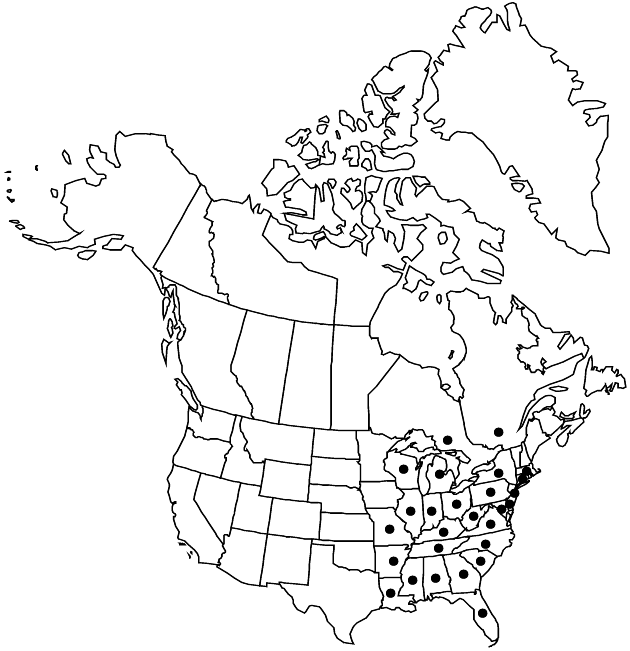Difference between revisions of "Liatris spicata"
Sp. Pl. 3: 1636. 1803.
FNA>Volume Importer |
RevisionBot (talk | contribs) m (Bot: Adding category Revised Since Print) |
||
| (3 intermediate revisions by 2 users not shown) | |||
| Line 8: | Line 8: | ||
}} | }} | ||
|common_names=Florist or marsh gayfeather | |common_names=Florist or marsh gayfeather | ||
| + | |special_status={{Treatment/ID/Special_status | ||
| + | |code=E | ||
| + | |label=Endemic | ||
| + | }} | ||
|basionyms={{Treatment/ID/Basionym | |basionyms={{Treatment/ID/Basionym | ||
|name=Serratula spicata | |name=Serratula spicata | ||
| Line 30: | Line 34: | ||
-->{{Treatment/Body | -->{{Treatment/Body | ||
| − | |distribution= | + | |distribution=Ont.;Que.;Ala.;Ark.;Conn.;Del.;Fla.;Ga.;Ill.;Ind.;Ky.;La.;Mass.;Md.;Mich.;Miss.;Mo.;N.C.;N.J.;N.Y.;Ohio;Pa.;S.C.;Tenn.;Va.;W.Va.;Wis. |
|discussion=<p>Varieties 2 (2 in the flora).</p><!-- | |discussion=<p>Varieties 2 (2 in the flora).</p><!-- | ||
--><p><i>Liatris spicata</i> is sold as cut flowers. It also is commonly sold as a garden plant in various genetic permutations (probably derived from <i></i>var.<i> spicata</i>, perhaps from <i>L. lancifolia</i>) and it apparently escapes cultivation. Reports from Arkansas, Connecticut, and Quebec probably reflect plants growing in or escaped from gardens.</p><!-- | --><p><i>Liatris spicata</i> is sold as cut flowers. It also is commonly sold as a garden plant in various genetic permutations (probably derived from <i></i>var.<i> spicata</i>, perhaps from <i>L. lancifolia</i>) and it apparently escapes cultivation. Reports from Arkansas, Connecticut, and Quebec probably reflect plants growing in or escaped from gardens.</p><!-- | ||
| Line 63: | Line 67: | ||
|basionyms=Serratula spicata | |basionyms=Serratula spicata | ||
|family=Asteraceae | |family=Asteraceae | ||
| − | |distribution= | + | |distribution=Ont.;Que.;Ala.;Ark.;Conn.;Del.;Fla.;Ga.;Ill.;Ind.;Ky.;La.;Mass.;Md.;Mich.;Miss.;Mo.;N.C.;N.J.;N.Y.;Ohio;Pa.;S.C.;Tenn.;Va.;W.Va.;Wis. |
|reference=None | |reference=None | ||
|publication title=Sp. Pl. | |publication title=Sp. Pl. | ||
|publication year=1803 | |publication year=1803 | ||
| − | |special status= | + | |special status=Endemic |
| − | |source xml=https:// | + | |source xml=https://bitbucket.org/aafc-mbb/fna-data-curation/src/2e0870ddd59836b60bcf96646a41e87ea5a5943a/coarse_grained_fna_xml/V19-20-21/V21_1326.xml |
|tribe=Asteraceae tribe Eupatorieae | |tribe=Asteraceae tribe Eupatorieae | ||
|genus=Liatris | |genus=Liatris | ||
| Line 74: | Line 78: | ||
}}<!-- | }}<!-- | ||
| − | -->[[Category:Treatment]][[Category:Liatris]] | + | --> |
| + | |||
| + | [[Category:Treatment]] | ||
| + | [[Category:Liatris]] | ||
| + | [[Category:Revised Since Print]] | ||
Latest revision as of 18:31, 6 November 2020
Plants (20–)40–110(–180) cm. Corms globose to slightly elongate. Stems glabrous. Leaves: basal and lower cauline 3–5-nerved, narrowly oblong-lanceolate to narrowly spatulate-oblanceolate, 120–350 × (2–)4–10(–20) mm (sometimes becoming more densely arranged distally), usually gradually reduced distally, essentially glabrous or sparsely villous, weakly gland-dotted (glandular hairs often not evident, bases of basal often fibrous-persistent). Heads in dense to loose, spiciform arrays. Peduncles usually 0, rarely 1–2 mm. Involucres turbinate-cylindric to turbinate-campanulate, 7–11 × 4–6 mm. Phyllaries in (3–)4–5 series, ovate to oblong, unequal, essentially glabrous, margins with hyaline borders, sometimes ciliolate, apices rounded to obtuse. Florets (4–)5–8(–14); corolla tubes glabrous inside. Cypselae (3.5–)4.5–6 mm; pappi: lengths ± equaling corollas, bristles barbellate.
Distribution

Ont., Que., Ala., Ark., Conn., Del., Fla., Ga., Ill., Ind., Ky., La., Mass., Md., Mich., Miss., Mo., N.C., N.J., N.Y., Ohio, Pa., S.C., Tenn., Va., W.Va., Wis.
Discussion
Varieties 2 (2 in the flora).
Liatris spicata is sold as cut flowers. It also is commonly sold as a garden plant in various genetic permutations (probably derived from var. spicata, perhaps from L. lancifolia) and it apparently escapes cultivation. Reports from Arkansas, Connecticut, and Quebec probably reflect plants growing in or escaped from gardens.
A geographic disjunction within Liatris spicata occurs between the coastal plain element (var. resinosa) and the inland/montane element (var. spicata), although plants morphologically referable to var. resinosa occasionally are encountered in montane North Carolina and Tennessee and var. spicata-like plants occur in the range of var. resinosa. Apparent intergrades between the two taxa are common, especially in Tennessee and Alabama. The geographical gap is widest in Georgia and Alabama. Neither variety occurs naturally west of the Mississippi River, except for a historical record of var. spicata in Oregon County, Missouri (Kellogg s.n., MO), where the population has now been genetically “swamped” by L. pycnostachya (G. A. Yatskievych, pers. comm.).
In both var. spicata and var. resinosa, marked variation (dimorphism) in head size occurs, the large-headed plants apparently occurring in scattered geographic enclaves without a broader geographic pattern. It seems possible that independent populational origins of polyploidy might underlie the variation.
Selected References
None.
Key
| 1 | Leaves: basal and proximal cauline (2–)4–8 mm wide (cauline usually abruptly reduced in size near midstem, continuing distally as linear, bractlike leaves); involucres 7–9 mm; phyllaries purplish to greenish; florets 5–6(–8); coastal plain | Liatris spicata var. resinosa |
| 1 | Leaves: basal and proximal cauline 4–10(–20) mm wide (cauline usually gradually reduced in size distally); involucres (7–)8–11 mm; phyllaries usually greenish; florets (4–)6–8(–12); montaneand inland | Liatris spicata var. spicata |